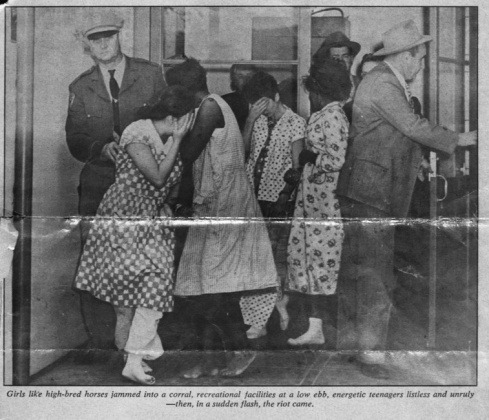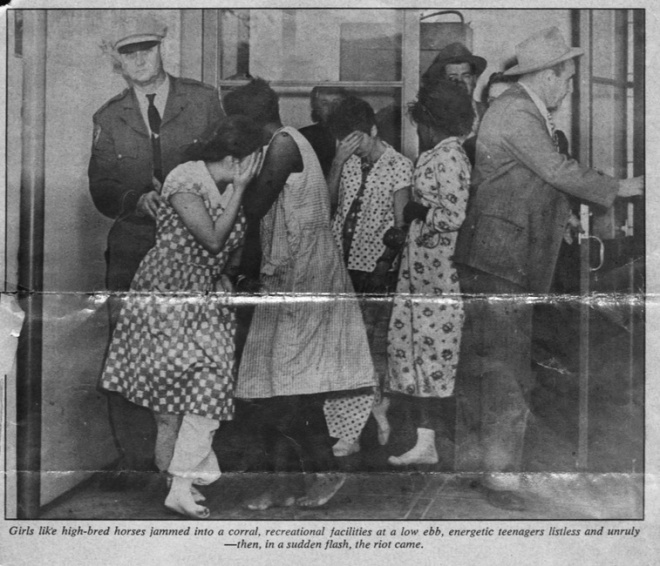
In March 20, 1953, violence erupted in the dining hall at the state-run Los Guilicos School for Girls on Pythian Road near Kenwood. The disturbance quickly grew to a full-fledged riot with more than 35 girls, ages 11 to 17, breaking windows and smashing furniture. Deputies from the Sonoma County Sheriff’s office, Santa Rosa and Sonoma police departments, and California Highway Patrol were called in to quell the unrest, but more riots broke out over the next four days. In the mayhem, several groups of girls escaped and more than 30 girls were injured. According to officials, the riots stemmed from “gang rivalries, race prejudice and homosexual problems.”
The Los Guilicos School for Girls was established in 1945 when the state of California purchased what was then called the historic Pythian House (and is now known as the Hood House or Hood Mansion and is part of the Regional Park system). The school was designed for delinquent – but not violent – girls, ages 11 to 17, from across the state who had been placed under the supervision of the California Youth Authority (CYA). Some had broken laws, many were from broken homes. The Los Guilicos School was an attempt at a new approach to address juvenile delinquency – a growing concern at the time and considered a mix of poor judgement and lack of parental guidance. Through the school, the aim to provide the young girl offenders with home-like surroundings and supportive relationships.
It was a great sentiment, but things obviously started to go awry at the school. For one thing, in October 1946, the school’s superintendent Dr. Elizabeth Van Arsdale ended up in a Sonoma County hospital after attempting suicide by overdosing on sleeping pills. Soonafter, Arsdale and two other founding members of the school, business manager George Winters and his wife, Novella, resigned amid reports of a jealous love triangle between the three.
In July 1947, Julia Combs stepped up to take the helm as the school’s new superintendent. Things stayed seemingly quiet at the school for a few years. There are small reports of various recreational activities hosted by the school or presented by girls from the school – anything from folk dancing to choir performances.
But later newspaper articles reveal months of mounting tensions between the school staff and the residents. Then, at 6 p.m. on March 20, 1953, those tensions exploded violently. Dining hall “chairs and dishes were sent crashing through windows amid screams and hysterical shouting,” wrote Denne Petitclerc in an article for the political and cultural magazine Fortnight.
Petitclerc, among other things, did a stint as a Korean War correspondent for the Press Democrat, but the rather dramatic language of this article hints at his future career as a screenwriter.
He continues:
“Supervisors lost control almost immediately. The riot spread like fire in a dry wheat field through the rest of the institution.”
“At the height of the rioting, sixty of the 159 girls housed at the institution wandered at large on the grounds, merging into packs and charging buildings, tossing stones and clods of dirt at windows. Clubs were made from loose lumber, toilets and sinks were torn from walls; a smashed Coca-Cola machine furnished refreshments and handy missiles.”
Florid descriptions aside, it’s an engrossing account of a very different reality in a very different time.
“Those four got out. The boys picked ’em up down the road. What they need is a good spanking,” Sonoma County’s chief criminal deputy is quoted saying.
What is clear is that the pent up anger of “raging teenage girls” was no match for common law enforcement tactics. Police officers from Sonoma County Sheriff’s office, Santa Rosa and Sonoma police departments, California Highway Patrol and Sonoma State Home Security Patrol were summoned to the scene. Then-Governor Earl Warren authorized the National Guard to go on standby basis to assist maintaining order.
“If you’ve never seen a teenage girl, gang-raised and street-trained, in absolute, uncontrolled fury, then you’ve never seen the height of emotion,” wrote Petitclerc.
If you’ve ever been faced with the problem of controlling that girl, who stands in front of you, hair-tousled, eyes red and furious, swearing unbelievable oaths in a shrill, hysterical voice, then you can partially understand one of the problems at Los Guilucos [sic].”
“If they were men or boys,” one officer told you, “we’d have this thing licked in an hour. But what are you going to do to a little girl to make her shut up?”
Some girls wrapped sweaters around their hands to break supposedly shatter-proof windows, or broke toilets and used the toilets to smash out windows, and then escaped through the broken glass.
At 9:30 p.m., 10 girls were caught near Kenwood. They had broken into a store and stolen liquor and food and were drunk when returned to the school.
Outbreaks of unrest continued for four more days, with officers placed on each ward to help keep order. On March 24, after another violent outburst from “inmates” when deputies attempted to apprehend a girl escaping across the lawn, some 41 girls were taken out of the building and booked in the Sonoma County Jail. There were 90 of 159 left at the school.
According to a Press Democrat article, a core group of six girls, who were led by one 14-year-old, instigated the first riot, which caused at least $4,000 in damage.
Why did the rioting happen? Some of it was attributed to tensions between the staff and residents, but Petitclerc also hints at tensions between the girls, stemming from homosexual relationships. Press Democrat articles by Frank Herbert also back up this conclusion, but it’s hard to tell if it’s the entire truth or just sensational news helping to sell newspapers. According to accounts from girl inmates, wrote Herbert, homosexual practices between “chicks” (female counterparts) and “gals” (male counterparts) were so common that it was the norm rather than an exception.
Some girls were in these relationships willingly, some were intimidated and coerced into them, and some had taken up pretended homosexual liaisons to hide from the other girls that they were not actually participating.
Relationships often took on a nuclear family model with “brothers” and “daddies.” There was even evidence of mock marriages and marriage ceremonies.
At a Parole Board hearing later that summer, school staff admitted that they were aware homosexuality was present at the school, but could not estimate to what extent.
According to one of the girls involved, the first riot was started because two girls who were “daddies” were sent away to Napa State Hospital.
The day the rioting started a note was intercepted by Superintendent Combs from the two girls being removed to Napa State Hospital. Addressed to “all you chicks,” it gave an address in Los Angeles and invited them “to have some more good times on the outs” [after being released].
In another article, Combs said that the “deviant practices” started with the arrival of about 15 girls sent from the Los Angeles Detention Home to the Los Guilicos School. Following the riots, most of those girls were segregated and sent to various county detention homes and other to state hospitals.
One of those girls, called “Mary,” but obviously not her real name, ended up in the Mendocino State Hospital, an institution for mentally “unbalanced” adults, not juveniles. She was to stay 90 days, but an editorial in the Ukiah News from July 23, 1953 pointed out that that window had long since passed. Mary had just had her 14 birthday, which the Ukiah Kiwanis Club celebrated for her with a cake and new dress, but she was soon to be released and sent back home, evidently to a drunken and poverty-stricken family unable to care for her, with no reasonable skills of any kind, like cooking or sewing or housekeeping “or any branch of domestic activity.”
It seems this was also one of the reasons Mary and her counterparts started the riots – she said they had nothing to do, no interests, no future.
In its wake, the rioting left more than 30 girls injured, one girl lost sight in an eye from glass splinters, more than 500 broken windows, hundreds of torn sheets, broken beds, dressers, torn clothing, and structural damage to the school itself.
The authorities admitted then that they were beaten, and the girls never forgot it. Early in May 1953 several girls attempted to burn down a building by setting fire to mattresses, but the fire was put out in time.
After that arson attempt the CYA began to regroup, hoping to salvage something out of the mess. However, superintendent Julia Combs resigned on May 19, saying she needed “a good rest,” but that her resignation had nothing to do with the riots.
Who knows what changed, but somehow the CYA seemed to right itself – perhaps by beefing up staff-to-resident ratios or improving communications between supervisors and staff, as was suggested at the Parole Board hearing. The school continued to operate, under a few new superintendents, until the property was sold to Sonoma County in the 1970s. It is now part of the county’s Regional Park system and the historic Hood Mansion is still standing today.
See the video tour here:

I’ll never take a hike again on Hood Mountain without thinking of the girls! You have a great eye for the interesting, quirky, grisly stories from our past. Who knew?
LikeLike
Would there be any records of girls that were there from 1950 to 1952?
LikeLike
I was sent to los guilicos school in 1971 from CYA i was on dorm 4 (Bella) for 1 year of course there were 2 guys dorm 5 & 6 then there was the white house that was the music building. i think of all the people i knew back then & think about them often & wonder what happened to them i still remember my cya state # im gonna take a trip over that way
LikeLike